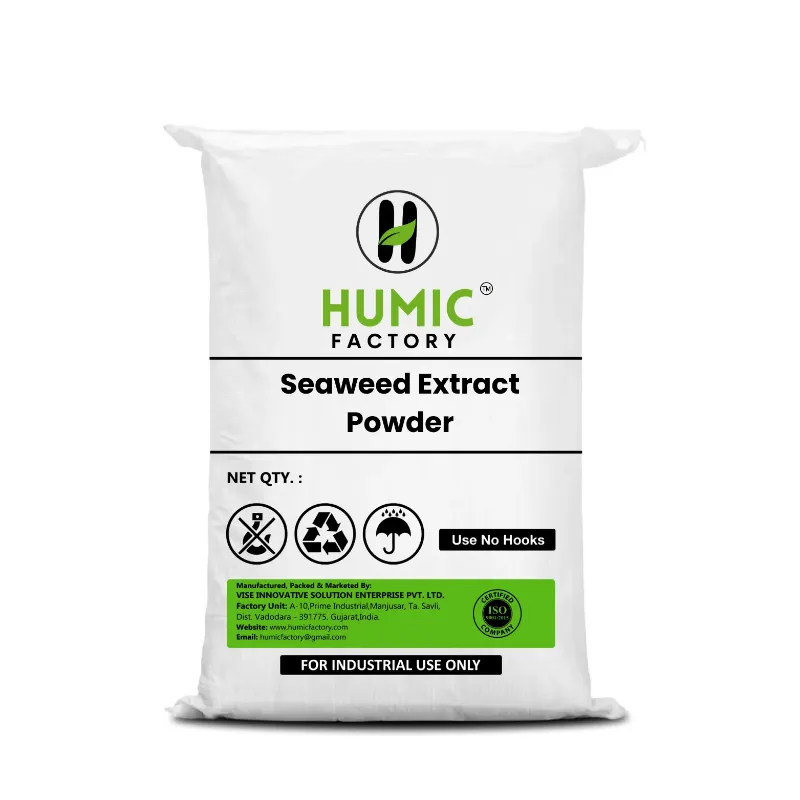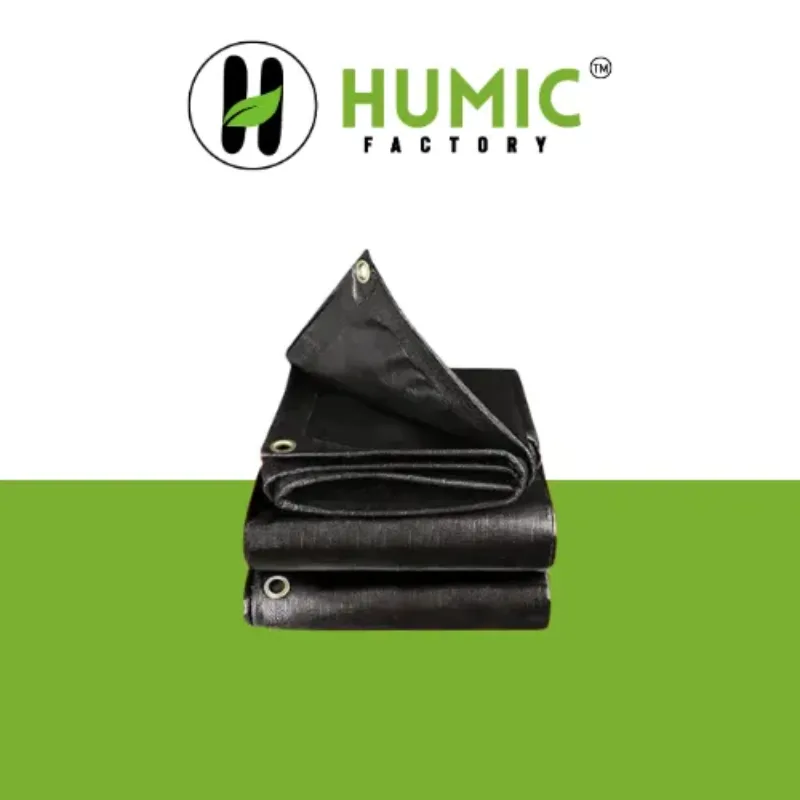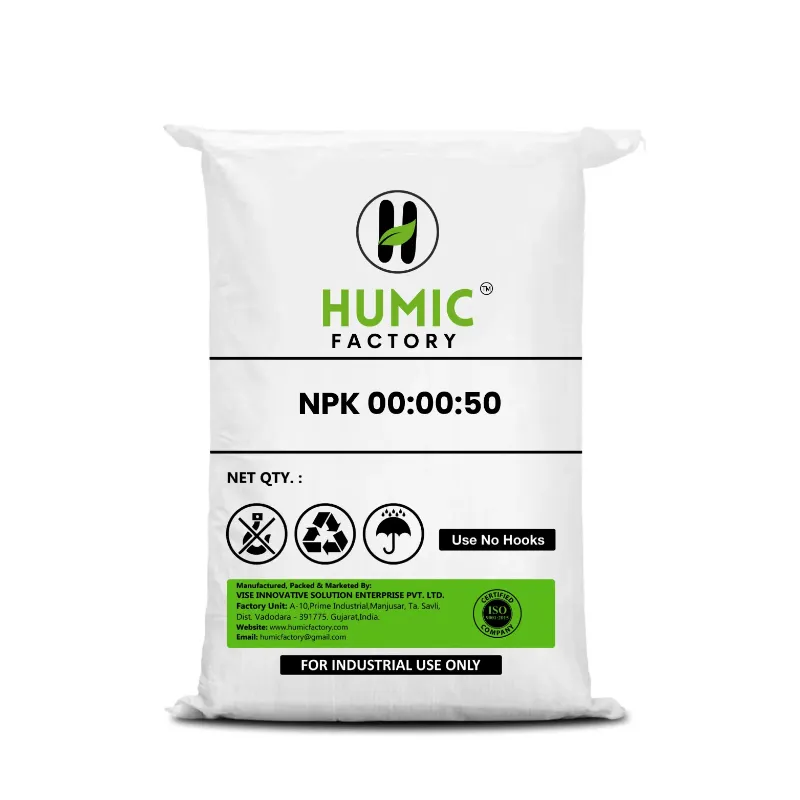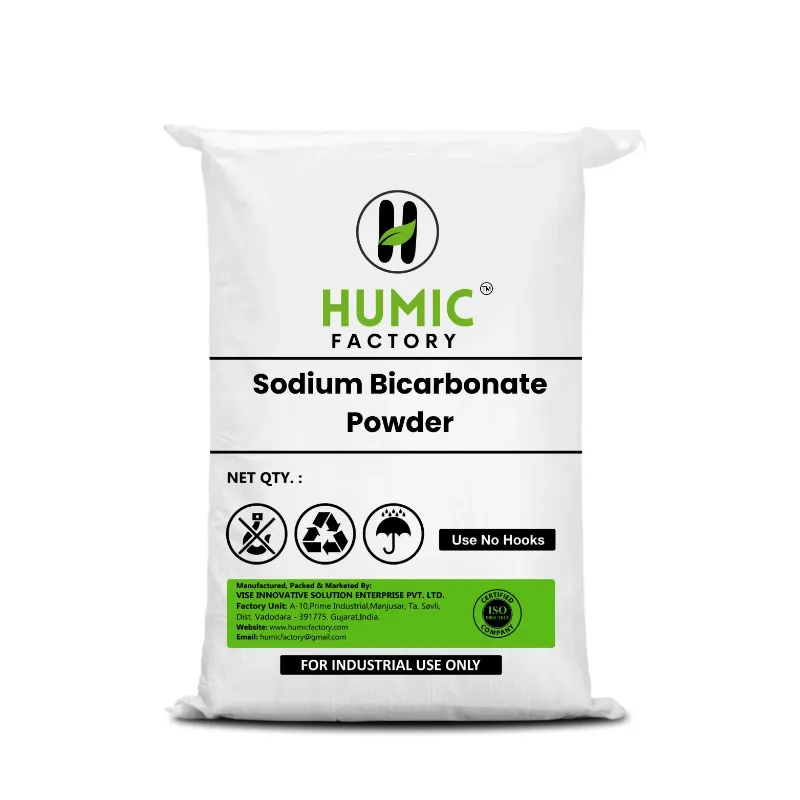Seaweed is a unique marine resource that is changing the way many different industries succeed all over the globe. With its naturally bioactive compounds and sustainable sources, its applications in agriculture, horticulture, cosmetics, and the environment are increasing.
In agriculture specifically, seaweed foliar spray is commonly used for the process of feeding crops through leaves, and seaweed has nutriments that nourish plants, as well as properties that help with stress tolerance and recovery. A seaweed-based foliar product will help farmers' respective markets increase agricultural productivity without reliance on many commercial chemically-synthesized chemical compounds.
Seaweed extract in foliar feed formulation from seaweed material is becoming popular among organic growers, as it delivers micronutrients, plant hormones, and minerals as trace elements through toasted seaweed to the cut foliage of plants for rapid absorption after application through surfaces of the leaves. This will provide plants with an immediate boost as it increases health and growth in sustaining minerals with proper timing of applications.
Another format for use in applications of seaweed is in a seaweed extract foliar spray if you wish to supply added plant energy from the 'revived' tonicity of the leaves, and this can be supplied to many crops; as well as an added benefit of increased flowering, fruit setting, and yield. Seaweed products are used for many agricultural and horticultural crops (in nursery crops) and also can be used in decision-making about hybrids and varietals in sustainable farming programs.
Introduction: Why Seaweed Application Is Gaining Global Popularity
Seaweed application is quickly becoming of importance across various sectors as it combines sustainability, adaptability, and efficiency. Seaweed is an ingredient in innovation that is becoming increasingly popular across agriculture, cosmetics, food preservation, and the environment. Seaweed is much more than just an ocean plant; it is emerging as an essential ingredient in global innovation. Seaweed application provides opportunities for innovation as society increasingly looks towards sustainable solutions rather than synthetic chemicals and resources derived from oil, coal, and natural gas.
Rising global demand for seaweed-based industries
There is a growing international interest in seaweed-based products as consumers and industry shift toward eco-friendly and health-promoting solutions. Countries such as South Korea, Norway, India, and China are committing to large-scale open-ocean seaweed farming to provide for a wide range of commitments to seaweed, including:
- Agriculture: Seaweed foliar spray and seaweed extract foliar feed enhance plant growth and improve soil health without using chemicals.
- Food Industry: Seaweed-based ingredients are being accepted into plant-based diets, even in dietary supplements.
- Textiles and Packages: Biopolymers from seaweed are being explored to replace plastic.Pharmaceuticals and Cosmetic: Bioactivity from the seaweed continues to be valued for its anti-inflammatory and anti-aging properties.
This demand is supporting new economic impacts in coastal communities, while re-discovering the important role of marine resources in sustainable development.
Multiple benefits of seaweed application across sectors
The many uses of seaweed have many benefits:
- In agricultural sciences, the use of a seaweed extract foliar spray has been shown to improve the nutrient uptake of the plants, and also allowing for crops to endure drought, pests and diseases.
- In skin care sciences, natural components of the seaweed have been found to help with hydration and revitalization.
- In food production, seaweed has essential minerals of benefit to our everyday diets like iodine and calcium.
- In packaging materials, biodegradable materials made from seaweed are helping limit some toxins in our environment.
The influence of seaweed foliar spray and seaweed extract foliar feed, brings to the agricultural sciences a different avenue for crop health, reduction of synthetic fertilizer dependency and productive organically grown crops.
Seaweed as a sustainability game-changer
Seaweed is rapidly becoming an icon of the sustainable revolution. Seaweed grows fast, doesn’t need freshwater, pesticides and fertilizers to grow, and absorbs large amounts of CO₂, making it a natural ally of climate action.
- We are shifting farming to eco-friendly methods with the use of seaweed application—particularly with seaweed extract foliar spray—which can allow farmers to reduce their footprint and still be productive.
- The increase of seaweed applications across industries is more than faddism, it is a step towards a greener, resilient future. Through an eco-friendly profile, seaweed is contributing to developmental change worldwide.
Seaweed Application in Sustainable Agriculture
As the world of sustainable agriculture advances, applying seaweed is considered a more natural alternative to synthetic inputs. Seaweed products supply both bioactive compounds plus a few trace elements and plant hormones that will improve soil quality as well as the yield of planted crops. Consequently, seaweed provides farmers an all-in-one natural product for improving the farm ecosystem while being as environmentally friendly as possible. Seaweed can be applied as a soil amend, compost activator or as a foliar spray, and serves organic farmers by enhancing the resilience of farm systems against climate-related challenges.
Seaweed extract foliar spray improving crop health
One of the most effective ways to deliver the benefits of seaweed to crops is using a seaweed extract foliar spray.
- The use of the foliar spray applied directly to the leaves of crops allows plants to quickly uptake nutrient micronutrients and bio-stimulants.
- The natural hormones of seaweed, including cytokinins, auxins, gibberellins trigger cell division and elongation, which lends itself to enhanced leaf development and thicker stems.
Foliar application also enhances chlorophyll development, increases the efficiency of photosynthesis, and at the same time improves the ability of plants to recover from drought or transplant shock.
The direct technique of applying seaweed foliar spray is particularly beneficial during important growth stages, like flowering and fruiting.
Seaweed extract foliar feed for nutrient-efficient farming
As farmers try to lessen fertilizer waste and enhance nutrient uptake they turn to seaweed extract foliar feed. Foliar feed is designed to support nutrition through the leaf surfaces, providing faster absorption into the plant system. Current soil fertilizers are susceptible to waste through runoff and leaching, while foliar feeds deliver essential nutrients like potassium, magnesium and zinc more effectively. The application of seaweed extract foliar feed allows the farmer to support healthy crops with less nutrients needed supply and a win for both productivity and sustainability.
Seaweed application reducing chemical fertilizer dependency
One of the important aspects of using seaweed in agriculture is the prospect of reducing reliance on chemical fertilizers. Synthetic chemicals are depleting soil health, contaminating waterways, and creating greenhouse gas emissions. The advantages to be gained from seaweed based solutions are that they help to soften the impacts of synthetic input use by:
- Increasing microbial activity in the soil
- Improving nutrient retention and soil structure
- Reducing the amount of nitrogen and phosphorus based fertilizers to take the place of or supplement with seaweed extract foliar spray or foliar feeds.
By switching or supplementing chemical fertilizers, farmers are able to lessen the impact on the environment and their crop performance. The switch to seaweed based approaches aid in the transition to regenerative agriculture, and contribute to cycling soil health to build the foundation of healthier and more resilient farming systems.
Seaweed Foliar Spray as a Game-Changer for Plant Growth
Over the past several years, the utilization of seaweed has emerged as a prominent approach to sustainable agriculture - specifically, through the application of seaweed foliar sprays. In contrast to conventional fertilizers that rely solely on soil uptake, foliar sprays, while on the leaves of the plant, fertilize more directly, produce quicker results, and are somehow more efficient. Seaweed takes advantage of its unique properties as it contains natural growth hormones, trace minerals, amino acids, and biostimulants that all elicit responses from plants. The physiological effects can promote stronger growth in plants as well as enhanced stress response and crop yield. Therefore, in response to the many benefits of seaweed foliar spray, farmers are starting to adopt them as an additive to their organic and conventional production systems.
How seaweed foliar spray enhances nutrient absorption
- Direct Leaf Uptake: Seaweed extract foliar application allows for leaf surface uptake through selective absorption; nutrients are absorbed quickly through the leaf outer surface stomates.
- Improved Photosynthate Production: Seaweed contains natural compounds like cytokinins and betaines that stimulate chlorophyll production resulting in a higher capacity for the plant to create energy through photosynthesis.
- Faster Response: Absent the soil, nutrients are taken directly up by the leaf surface and plants often respond in only a few days; if low on those nutrients it can happen much quicker.
- Salted Micro-nutrient Fulfilment: Seaweed contains a wide range of naturally occurring micronutrients. Some of these are very critical to plant metabolic processes like Mg, Zn and K.
Boosting stress tolerance and disease resistance naturally
- Managing Abiotic Stress: Seaweed foliar application mitigates drought, salinity, heat and cold stress through its facilitative role in building an internal forest of stress-defense mechanisms within the plant.
- Regulation of Hormonal Activity: Seaweed extract is a great source of plant hormones like auxins and gibberellins that assist in management of plant responses when plants are under stress.
- Improved Immune Function: The polysaccharides and antioxidants associated with the seaweed extract foliar feed help to synergistically stimulate a plants inherent immune system reducing the plant's potential to develop fungal, bacterial, and virus infections.
- Recovery from Transplant Shock: Using a seaweed foliar application immediately after a transplant or a prune will stimulate establishment of the roots and will dramatically reduce transplant shock.
Application techniques for seaweed foliar spray on crops
- Dilution and Mixing: Always dilute seaweed extract foliar spray as recommended—typically 5–10 ml per liter of water, depending on the product and crop type.
- Timing Matters: Apply during cooler times of the day (early morning or late afternoon) to maximize absorption and avoid evaporation.
- Frequency: For most crops, spraying every 10–15 days during the growing season ensures sustained benefits.
- Equipment: Use a fine mist sprayer for uniform coverage on the leaf surface. Large-scale farmers may opt for drone-assisted spraying or high-volume sprayers.
- Compatibility: Seaweed foliar spray can often be combined with other biological or organic treatments, but a compatibility test is recommended before tank mixing.
Seaweed Application for Climate Action and Marine Sustainability
In light of climate change, the agricultural and environmental sectors are scrambling to develop nature-based solutions to address issues associated with climate change. One of the most innovative and promising advancements is seaweed, with applications for land-based agriculture as well as marine environments. Seaweed has the potential for serious value creation through carbon capture, marine biodiversity recovery, and nutrient farming, all of which contribute to our global sustainability challenges. Seaweed has value from seaweed foliar spray in agriculture, to entire kelp forests functioning as carbon sinks, even the "magnitude of seaweed" in value is starting to appear.
Carbon sequestration through large-scale seaweed farming
Natural Carbon Capture: Seaweed captures CO₂ during photosynthesis very efficiently compared to land-based plants, with some species having rates of carbon sequestration similar to that of tropical forests.
- Oceanic Carbon Sink: As seaweed biomass sinks to the ocean floor, the carbon captured can stay there for decades or centuries.
- Blue Carbon Credits: The ecological properties of seaweeds are being studied as a potential element of carbon offset programmes focused on blue carbon credits, as well as a viable contributor to blue carbon credits as a large-scale seaweed application.
- Scalable: Farming seaweeds has no need for freshwater, arable land, or chemical inputs, bringing scalability in ocean areas with coastlines, and without stress on terrestrial resources.
Marine ecosystem restoration using kelp forests
- Habitat Creation: Kelp forests support marine life such as fish, crustaceans, and mollusks by providing shelter and food, thereby enhancing biodiversity.
- Erosion Control: Dense kelp growth helps stabilize ocean floors and reduce coastal erosion, benefiting fisheries and shoreline communities.
- Water Quality Improvement: Seaweed naturally absorbs excess nutrients like nitrogen and phosphorus, helping to reverse eutrophication in polluted coastal areas.
- Sustainable Inputs: Once harvested, kelp can be used in seaweed extract foliar feed, offering a circular solution from ocean to agriculture.
Seaweed cultivation as a zero-input farming solution
- No Need for Irrigation or Fertilizers: Seaweed absorbs nutrients directly from seawater, making it a zero-input farming system that doesn’t deplete freshwater resources or rely on synthetic fertilizers.
- Low-Energy Production: Unlike energy-intensive crops, seaweed grows rapidly with minimal human intervention, reducing the carbon footprint of food and feed production.
- Biofertilizer Potential: Harvested seaweed is processed into products like seaweed extract foliar spray and seaweed foliar spray, which are increasingly replacing chemical fertilizers in sustainable agriculture.
- Integrated Aquaculture Systems: Seaweed can be co-cultivated with shellfish or fish to create mutually beneficial ecosystems, enhancing overall farm productivity and environmental resilience.
Seaweed Application in Packaging and Bioplastic Innovations
The global push to reduce plastic pollution and adopt sustainable alternatives has led to significant advancements in seaweed application across packaging and materials science. Seaweed is now being explored not only for its agricultural benefits like seaweed extract foliar spray but also as a raw material in developing biodegradable packaging and bioplastics. Its naturally occurring polymers, such as alginate and carrageenan, offer promising alternatives to synthetic plastics, contributing to both environmental sustainability and innovation in the packaging industry.
Developing seaweed-based packaging as a plastic alternative
Seaweed-based packaging is made from extracted seaweed compounds that form film-like materials. These are compostable, safe for food contact, and biodegradable—often breaking down within weeks in natural conditions.
Key Benefits of Seaweed-Based Packaging:
Eco-Friendly Innovation: Products like edible wrappers and compostable sachets are entering markets, thanks to breakthrough seaweed applications.
- Food-Safe Nature: These materials are ideal for packaging perishable goods due to their natural antimicrobial properties.
- Global Demand: Sustainable packaging is witnessing rising demand, and seaweed offers a scalable, environmentally benign solution.
Scaling production of seaweed bioplastics
While seaweed packaging innovations are promising, scaling remains a challenge. However, ongoing advancements in material science and aquaculture are making mass production feasible.
Challenges and Solutions in Scaling:
- Raw Material Supply: Expansion of seaweed farms can sustainably meet the demand for bioplastics.
- Processing Technology: Developing efficient extraction and molding technologies for compounds like alginate and agar is essential.
- Investment and Policy Support: Government policies that support marine farming and ban single-use plastics are accelerating the growth of seaweed bioplastics.
Additionally, unlike seaweed foliar spray and seaweed extract foliar feed, which require minimal processing, bioplastics need refined manufacturing infrastructure to meet commercial quality and durability standards.
Seaweed extract innovations for eco-friendly material production
Beyond packaging films, seaweed extracts are being used to develop versatile biodegradable materials in sectors ranging from agriculture to electronics.
Innovative Applications of Seaweed Extracts:
- Mulch Films: Seaweed bioplastics can be used as soil-covering films that degrade naturally and also act as a seaweed foliar spray enhancer when mixed with nutrients.
- 3D Printing Filaments: Seaweed-based biopolymers are now being explored for 3D printing sustainable objects.
- Agricultural Coatings: Seaweed compounds serve as binding agents and biodegradable coatings in seaweed extract foliar feed products, eliminating synthetic carriers.
Economic Growth Driven by Global Seaweed Application
The rise in seaweed application across industries—from agriculture to packaging—has unlocked significant economic opportunities worldwide. The global market for seaweed and its derivatives is expanding rapidly due to increasing demand for sustainable products. This growth is fueled by innovative startups, government support, and the economic empowerment of coastal communities engaged in aquaculture.
Seaweed market expansion and investment opportunities
The global seaweed industry, once focused primarily on food and fertilizers, is now diversifying into biotechnology, packaging, pharmaceuticals, and more. As demand surges for natural solutions like seaweed extract foliar feed and seaweed foliar spray, investors and businesses are turning their attention to seaweed as a scalable, renewable commodity.
Global Seaweed Market Overview
Rising Demand: Sustainable agriculture products like seaweed liquid fertilizers and seaweed extract foliar spray are increasingly sought by eco-conscious farmers.
- Government Support: Several countries (e.g., India, Indonesia, South Korea) are providing subsidies and technical assistance for seaweed cultivation.
- Foreign Direct Investment: Interest in marine agritech has led to increased FDI in coastal economies, encouraging localized production.
Startup innovations in algae technology
Startups are revolutionizing the seaweed application ecosystem by developing value-added products that extend beyond traditional uses.
Key Innovation Areas:
- Agri-biostimulants: Enhancing crop growth through precision seaweed foliar spray formulations.
- Algae-Based Feed: Sustainable livestock and aquaculture feed that reduces methane emissions.
- Bioplastic Alternatives: Startups are using seaweed extract foliar feed byproducts to manufacture biodegradable materials.
- Carbon Credit Models: New businesses are capitalizing on the carbon sequestration properties of seaweed farming for carbon offset trading.
Economic benefits for coastal communities and aquaculture
One of the most transformative aspects of the seaweed industry is its impact on coastal livelihoods. Seaweed farming requires minimal input and provides quick yields, making it ideal for small-scale fishers and farmers.
Community-Level Economic Advantages:
- Employment Generation: Seaweed farming is labor-intensive and creates jobs in farming, drying, processing, and transport.
- Women's Empowerment: In regions like Southeast Asia and East Africa, women lead and manage a large portion of seaweed farming operations.
- Climate Resilience: Seaweed cultivation boosts local economies without depleting marine resources or requiring freshwater and fertilizers.
Example Table: Coastal Economic Impact – Indonesia Case Study
Challenges in Scaling Global Seaweed Application
The potential of seaweed application across agriculture, packaging, and climate-smart solutions is immense—but scaling this green resource globally is not without its challenges. Despite its proven benefits in areas like seaweed foliar spray, bioplastics, and ecosystem restoration, several structural and technological barriers limit its widespread adoption and commercialization.
Supply chain and logistics barriers
The seaweed industry currently suffers from fragmented supply chains and logistical constraints, particularly in developing coastal regions.
Key Challenges:
- Limited Processing Infrastructure: Many seaweed-producing areas lack access to modern drying, milling, and extraction facilities, which are critical for producing value-added products like seaweed extract foliar feed.
- High Transport Costs: Fresh seaweed is bulky and perishable. Transporting it without immediate processing adds significant overhead.
- Seasonal Availability: Seaweed yields vary by season and location, making consistent supply difficult to maintain year-round.
- Cold Chain Requirements: For certain applications, especially in food and cosmetics, maintaining a cold chain adds complexity and cost.
Regulatory approvals for seaweed-based products
The regulatory landscape for seaweed varies significantly by country, creating uncertainty for manufacturers and investors.
Core Regulatory Issues:
- Lack of Harmonized Standards: No universal standard currently exists for classifying or approving seaweed extract foliar spray or fertilizers, leading to export/import restrictions.
- Food and Feed Safety Testing: Edible seaweed and agricultural extracts must pass strict safety tests for heavy metals, iodine levels, and microbial contamination.
- Environmental Impact Assessments: Large-scale seaweed farming projects often require detailed ecological assessments, which can delay permits.
- Labeling Requirements: Governments are developing stricter guidelines on organic labeling for inputs like seaweed foliar spray, especially in Europe and North America.
Technological advancements needed for mass production
To scale seaweed application globally, innovation must bridge the gap between small-scale harvesting and industrial-scale output.
Technology Gaps:
- Mechanized Harvesting: Most seaweed is harvested manually. Mechanization would increase yield but risks damaging marine ecosystems if not properly implemented.
- Extraction Technologies: Current processes to derive high-quality seaweed extract foliar feed are energy-intensive and costly. Cleaner, scalable methods are needed.
- Precision Agriculture Integration: Integrating seaweed-based inputs into AI-powered and IoT-driven farming systems is still in the early stages.
- Product Stability and Shelf Life: Research is needed to extend the shelf life of liquid products like seaweed extract foliar spray while preserving nutrient content.
Frequently Asked Questions (FAQs)
Q1. What is seaweed application and how is it used in industries?
Seaweed application refers to the use of seaweed in various industries such as agriculture, packaging, cosmetics, and biofuels. In agriculture, it’s mainly used in the form of seaweed extract foliar spray and fertilizers for enhancing crop growth naturally.
Q2. How does seaweed extract foliar spray benefit crops?
Seaweed extract foliar spray delivers micronutrients and growth hormones directly to plant leaves, improving nutrient absorption, boosting resistance to stress, and enhancing overall plant health and yield.
Q3. What is the difference between seaweed foliar spray and seaweed extract foliar feed?
While both are applied to crops, seaweed foliar spray focuses on immediate nutrient delivery through leaves, whereas seaweed extract foliar feed may include a broader range of bioactive compounds intended for systemic plant improvement over time.
Q4. Is seaweed application safe for organic farming?
Yes, seaweed application is widely accepted in organic farming due to its natural origin, non-toxic profile, and contribution to soil health without harmful residues.
Q5. Can seaweed application help reduce synthetic fertilizer use?
Absolutely. Regular use of seaweed foliar spray and seaweed extract foliar feed can reduce the dependency on chemical fertilizers by naturally enriching soil and boosting plant resilience.
Conclusion – Embrace the Power of Seaweed Application to Build a Sustainable Future
The growing global focus on environmental responsibility, resource efficiency, and sustainable agriculture makes seaweed application more relevant than ever. As a natural, regenerative marine resource, seaweed offers a wide array of benefits—from improving soil structure and plant health to reducing our dependence on chemical fertilizers and non-biodegradable packaging.
In the agricultural sector, seaweed foliar spray and seaweed extract foliar feed are revolutionizing crop nutrition. These solutions enhance nutrient uptake, strengthen plant immunity, and improve resistance to drought and pests—without harming the environment. Seaweed extract foliar spray, in particular, is praised for its fast-acting delivery of essential minerals and growth hormones, proving to be a vital tool in organic and regenerative farming.
Beyond agriculture, seaweed application spans across industries—from biodegradable packaging and textiles to biofuels and cosmetics—making it a versatile solution to some of the world's most pressing sustainability challenges.
By adopting seaweed-based solutions, we don’t just enhance productivity—we contribute to climate resilience, reduce carbon emissions, and support marine biodiversity. Embracing seaweed is not merely a trend but a strategic shift toward a greener and more sustainable future.
Now is the time to integrate seaweed foliar spray and seaweed extract foliar feed into mainstream practices, champion innovations in seaweed application, and scale solutions that respect both the planet and its people.






